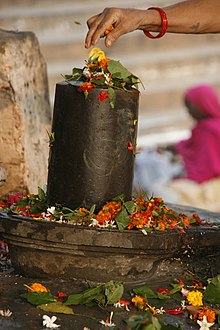ศิวลึงค์

ศิวลึงค์ ลึงค์ หรือ ลิงค์ (สันสกฤต: लिङ्गं liṅgaṃ หมายถึง เครื่องหมาย สัญลักษณ์ เพศ องคชาต การอนุมาน คัพภะที่ก่อเกิดลูกหลานชั่วนิรันดร์[1][2]) เป็นสัญลักษณ์ของพระศิวะเทพเจ้าในศาสนาฮินดู ใช้ในการบูชาสักการะในโบสถ์วิหารฮินดู[3] ในศาสนาฮินดูยังเป็นที่ถกเถียงกันว่าศิวลึงค์เป็นตัวแทนทางกายภาพของเทพเจ้าหรือเป็นเครื่องหมายทางจิตวิญญาณ[4]
ศิวลึงค์ ถูกแปลความว่าเป็นเครื่องหมายแห่งพลังสร้างสรรค์ในบุรุษเพศที่มาจากองคชาต[5] แม้ว่าในปัจจุบันชาวฮินดูส่วนใหญ่จะมองศิวลึงค์เป็นเครื่องหมายแห่งพลังศักดิ์สิทธิ์มากกว่าเครื่องหมายทางเพศ[6][7][8][9][10][11] ศิวลึงค์มักปรากฏอยู่พร้อมกับโยนี สัญลักษณ์ของพระแม่ปารวตีอันบ่งบอกถึงพลังสร้างสรรค์ของสตรีเพศ[5] การที่ศิวลึงค์และและโยนีอยู่ร่วมกันแสดงถึง "ความเป็นสองในหนึ่งเดียวที่แยกออกจากกันไม่ได้ของบุรุษและสตรี อวกาศที่หยุดนิ่งและเวลาซึ่งเคลื่อนที่อันเป็นต้นกำเนิดของสรรพชีวิต"[12] ตั้งแต่สิ้นคริสต์ศตวรรษที่ 19 นักวิชาการตีความว่าศิวลึงค์และโยนีเป็นอวัยวะเพศชายและหญิง ขณะที่ชาวฮินดูเห็นว่าทั้งสองสิ่งเป็นเครื่องแสดงถึงหลักการที่ว่าหญิงและชายไม่อาจแยกออกจากกันได้และเป็นเครื่องหมายแห่งการก่อกำเนิด[8]
ดูเพิ่ม
อ้างอิง
- ↑ Spoken Sanskrit Dictionary
- ↑ "A Practical Sanskrit Dictionary". คลังข้อมูลเก่าเก็บจากแหล่งเดิมเมื่อ 2012-12-15. สืบค้นเมื่อ 2013-02-09.
- ↑ Hinduism: Beliefs and Practices, by Jeanne Fowler, pgs. 42–43, at Books.Google.com[ลิงก์เสีย]
- ↑ Wendy Doniger, "God's Body, or, The Lingam Made Flesh: Conflicts over the Representation of the Sexual Body of the Hindu God Shiva" Social Research: An International Quarterly Volume 78, Number 2 / Summer 2011 p 485-508
- ↑ 5.0 5.1 Zimmer, Heinrich Robert (1946). Campbell, Joseph (บ.ก.). Myths and symbols in Indian art and civilization. Princeton, New Jersey: Princeton University Press. p. 126. ISBN 0-691-01778-6.
But the basic and most common object of worship in Shiva shrines is the phallus or lingam.
- ↑ Blurton, Richsrd (16 Nov 1992). Hindu Art (Art History). British Museum Press. pp. 164. ISBN 978-0-7141-1442-2.
... an enshrined linga today will be lovingly garlanded and attended by young women and elderly matrons alike, but without any overt suggestions of sexuality. In traditional Indian society, the linga is rather seen as a symbol of the energy and potentiality of the God.
- ↑ Mudaliyar, Sabaratna. "Lecture on the Shiva Linga". Malaysia Hindu Dharma Mamandram. คลังข้อมูลเก่าเก็บจากแหล่งเดิมเมื่อ 2012-06-30. สืบค้นเมื่อ 27 March 2012.
- ↑ 8.0 8.1 "lingam". Encyclopædia Britannica. 2010.
Since the late 19th century some scholars have interpreted the lingam and the yoni to be representations of the male and female sexual organs. To practicing Hindus, however, the two together are a reminder that the male and female principles are inseparable and that they represent the totality of all existence.
- ↑ Isherwood, Christopher (1983). Ramakrishna and His Disciples. Early days at Dakshineswar: Vedanta Press,U.S. p. 48. ISBN 978-0-87481-037-0.
- ↑ Sivananda (1996 (web edn. 2000)). Lord Siva and His Worship. Worship of Siva Linga: The Divine Life Trust Society. ISBN 81-7052-025-8.
The popular belief is that the Siva Lingam represents the phallus or the virile organ, the emblem of the generative power or principle in nature. This is not only a serious mistake, but also a grave blunder. In the post-Vedic period, the Linga became symbolical of the generative power of the Lord Siva. Linga is the differentiating mark. It is certainly not the sex-mark.
{cite book}: ตรวจสอบค่าวันที่ใน:|year=(help) - ↑ Subramuniyaswami, Sivaya. "Satguru". Dancing With Shiva. Himalayan Academy. คลังข้อมูลเก่าเก็บจากแหล่งเดิมเมื่อ 2012-03-27. สืบค้นเมื่อ 27 March 2012.
- ↑ Jansen, Eva Rudy (2003) [1993]. The book of Hindu imagery: gods, manifestations and their meaning. Binkey Kok Publications. pp. 46, 119. ISBN 90-74597-07-6.